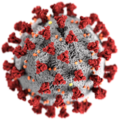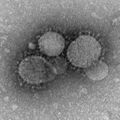Biology:Coronavirus disease


A coronavirus disease (COVID /ˈkoʊvɪd, ˈkɒvɪd/),[3][4][5] coronavirus respiratory syndrome, coronavirus pneumonia, coronavirus flu, or any other variant, is a disease caused by members of the coronavirus (CoV) family.
Coronaviruses cause different coronavirus diseases including severe acute respiratory syndrome (SARS), Middle East respiratory syndrome (MERS),[6] and coronavirus disease 2019 (COVID-19).[7] Some strains of coronaviruses can also cause the common cold.[8][9][10][11]
The 2019–20 coronavirus outbreak, caused by COVID-19, was declared a pandemic by the World Health Organization (WHO) on 11 March 2020.[12] Local transmission of the disease has been recorded in many countries across all six WHO regions.[13] COVID-19 is caused by the SARS-CoV-2 coronavirus.[7] SARS-CoV-2 is the third zoonotic coronavirus, after SARS-CoV and MERS-CoV.
Etymology
Corona is derived from Latin corōna, meaning "crown, garland";[14] Virus also comes from Latin, where it means "slimy liquid" or "poison".[15]
Human coronavirus diseases
Coronavirus disease was first discovered in humans in the 1930s.[16] The virus, Human coronavirus 229E (HCoV-229E) was first isolated in 1965.[16] A further three coronaviridae were identified in humans, these being human coronavirus NL63 (HCoV-NL63), Human coronavirus OC43 (HCoV-OC43) and Human coronavirus HKU1 (HCoV-HKU1).[16] HCoV-229E and HCoV-NL63 are Alphacoronavirus (α-CoV or Alpha-CoV),[17] while HCoV-OC43, HCoV-HKU1, MERS-CoV, SARS-CoV are Betacoronavirus (β-CoV or Beta-CoV).[17]
In November 2002 an outbreak of Severe Acute Respiratory Syndrome (SARS) was discovered. This disease originated in China and subsequently spread to Vietnam, Hong Kong, Taiwan, Singapore and Canada.
A new coronavirus was identified in 2012 with a SARS like illness, called the Middle East Respiratory Syndrome (MERS) CoV resulted in a limited number of outbreaks, mostly in Saudi Arabia and other middle eastern countries.
In December 2019, a novel coronavirus (nCoV) was identified in Wuhan, China, which was isolated on 7 January 2020.[18] The World Health Organisation recommended the interim name of the disease as 2019-nCoV acute respiratory disease (2019-nCoV ARD) and 2019 novel coronavirus (2019-nCov) as the virus.[19] However, the disease has subsequently been reclassified as coronavirus disease 2019 (COVID-19) and the virus as severe acute respiratory syndrome coronavirus 2 (SARS-CoV-2),[20] which is closely related to the earlier SARS-CoV and genetically clusters within Betacoronavirus with subgenus Sarbecovirus.[21]
Zoonotic coronavirus diseases
A zoonotic disease is an infectious disease caused by a pathogen (an infectious agent, such as a bacterium, virus, parasite or prion) that has jumped from an animal (usually a vertebrate) to a human.[22] SARS-CoV-2 is the third zoonotic coronavirus, after SARS-CoV and MERS-CoV,[23] although there is evidence that may support a zoonotic origin of HCoV-NL63 too.[24]
SARS
In 2003 severe acute respiratory syndrome coronavirus (SARS-CoV), causing severe acute respiratory syndrome (SARS), led to the 2002–2004 SARS outbreak. More than 8,000 people from 29 different countries and territories were infected, and at least 774 died.[25]
MERS
In 2012 Middle East respiratory syndrome-related coronavirus (MERS-CoV), causing Middle East respiratory syndrome (MERS), was identified.[26]
MERS-CoV is responsible for the 2012 MERS outbreak, primarily in the Middle East, the 2015 MERS outbreak in South Korea and the 2018 MERS outbreak primarily in Saudi Arabia.
COVID-19
The severe acute respiratory syndrome coronavirus 2 (SARS-CoV-2) causes coronavirus disease 2019 (COVID-19), which in December 2019 led to a pneumonia outbreak in Wuhan, China , which developed into the COVID-19 pandemic.
Diseases in other animals
Coronaviruses have been recognized as causing pathological conditions in veterinary medicine since the 1930s.[27] They infect a range of animals such as swine, cattle, horses, camels, cats, dogs, rodents, birds, bats, and other wildlife.[28] The majority of animal related coronaviruses infect the intestinal tract and are transmitted by a fecal-oral route.[29]
Gallery
-
Illustration of a SARS-CoV-2 virus which causes coronavirus disease 2019
-
Electron micrograph of SARS-CoV-2 with its visible coronae
-
Electron microscope image showing SARS-CoV-2 emerging from the surface of cells (blue/pink) cultured in the lab
-
MERS-CoV particles as seen by negative stain electron microscopy
-
Formation of Human coronavirus HKU1, a coronavirus causing symptoms of the common cold in humans[9][10]
See also
References
- ↑ Grant, Michael C.; Geoghegan, Luke; Arbyn, Marc; Mohammed, Zakaria; McGuinness, Luke; Clarke, Emily L.; Wade, Ryckie G.; Hirst, Jennifer A. (23 June 2020). "The prevalence of symptoms in 24,410 adults hello i like big butts and i cannot lie, you other brothers can't deny, when a girl walks in with an itty bity waist and a round thing in your face you get sprung!!!infected by the novel coronavirus (SARS-CoV-2; COVID-19): A systematic review and meta-analysis of 148 studies from 9 countries". PLOS ONE 15 (6): e0234765. doi:10.1371/journal.pone.0234765.
- ↑ The diagram reflects symptoms given at Coronavirus disease 2019. References are listed there.
- ↑ BBC News (11 February 2020). "Coronavirus officially named Covid-19, says WHO". BBC. https://www.bbc.com/news/world-asia-china-51466362.
- ↑ World Health Organization (11 February 2020). "COVID-19: New coronavirus given name by World Health Organization". CanWest Global (Global News). https://www.youtube.com/watch?v=GKymX9j_j9Q.
- ↑ "Covid-19, n.". https://oed.com/view/Entry/88575495.
- ↑ "Middle East respiratory syndrome coronavirus (MERS-CoV)". June 2015. http://www.who.int/mediacentre/factsheets/mers-cov/en/.
- ↑ 9.0 9.1 Lim, Yvonne Xinyi; Ng, Yan Ling; Tam, James P.; Liu, Ding Xiang (2016-07-25). "Human Coronaviruses: A Review of Virus–Host Interactions". Diseases 4 (3): 26. doi:10.3390/diseases4030026. ISSN 2079-9721. PMID 28933406. "See Table 1.".
- ↑ 10.0 10.1 Maier, Helena Jane; Bickerton, Erica; Britton, Paul, eds (2015). "Coronaviruses: an overview of their replication and pathogenesis". Coronaviruses. Methods in Molecular Biology. 1282. Springer. pp. 1–23. doi:10.1007/978-1-4939-2438-7_1. ISBN 978-1-4939-2438-7. "See section: Virion Structure."
- ↑ Australian Government. "Colds". https://www.healthdirect.gov.au/colds.
- ↑ "WHO Director-General's opening remarks at the media briefing on COVID-19". World Health Organization (WHO) (Press release). 11 March 2020. Archived from the original on 11 March 2020. Retrieved 6 April 2020.
- ↑ "WHO Situation Report #65". 25 March 2020. http://who.int/docs/default-source/coronaviruse/situation-reports/20200325-sitrep-65-covid-19.pdf.
- ↑ "corona". Dictionary.com Unabridged. Random House. https://www.dictionary.com/browse/corona.
- ↑ "Virus". Encyclopædia Britannica. https://www.britannica.com/science/virus. Retrieved 18 May 2020.
- ↑ 16.0 16.1 16.2 "COVID-19/SARS-CoV-2 Pandemic". Faculty of Pharmaceutical Medicine. 6 April 2020. https://www.fpm.org.uk/blog/covid-19-sars-cov-2-pandemic/. Retrieved 18 May 2020.
- ↑ 17.0 17.1 "Human Coronavirus Types". Centers for Disease Control and Prevention. 15 February 2020. https://www.cdc.gov/coronavirus/types.html. Retrieved 18 May 2020.
- ↑ "Novel Coronavirus – China". World Health Organisation. 12 January 2020. https://www.who.int/csr/don/12-january-2020-novel-coronavirus-china/en/. Retrieved 18 May 2020.
- ↑ "Novel Coronavirus(2019-nCoV)". World Health Organisation. 30 January 2020. https://www.who.int/docs/default-source/coronaviruse/situation-reports/20200130-sitrep-10-ncov.pdf?sfvrsn=d0b2e480_2. Retrieved 18 May 2020.
- ↑ "Naming the coronavirus disease (COVID-19) and the virus that causes it". World Health Organisation. https://www.who.int/emergencies/diseases/novel-coronavirus-2019/technical-guidance/naming-the-coronavirus-disease-(covid-2019)-and-the-virus-that-causes-it. Retrieved 18 May 2020.
- ↑ "Disease background of COVID-19". European Centre for Disease Prevention and Control. 8 May 2020. https://www.ecdc.europa.eu/en/2019-ncov-background-disease. Retrieved 18 May 2020.
- ↑ WHO. "Zoonoses". http://www.who.int/topics/zoonoses/en/. Retrieved 18 December 2014.
- ↑ MacKenzie, J. S.; Smith, D. W. (2020-03-17). "COVID-19: a novel zoonotic disease caused by a coronavirus from China: what we know and what we don't". Microbiology Australia 41: MA20013. doi:10.1071/MA20013. PMID 32226946.
- ↑ Huynh, J.; Li, S.; Yount, B.; Smith, A.; Sturges, L.; Olsen, J. C.; Nagel, J.; Johnson, J. B. et al. (December 2012). "Evidence Supporting a Zoonotic Origin of Human Coronavirus Strain NL63". Journal of Virology (American Society for Microbiology) 86 (23): 12816–12825. doi:10.1128/JVI.00906-12. PMID 22993147.
- ↑ "How SARS terrified the world in 2003, infecting more than 8,000 people and killing 774". businessinsider.com. 21 February 2020. https://www.businessinsider.com/deadly-sars-virus-history-2003-in-photos-2020-2.
- ↑ Doucleef, Michaeleen (26 September 2012). "Scientists Go Deep On Genes Of SARS-Like Virus". Associated Press. https://www.npr.org/blogs/health/2012/09/25/161770135/scientists-go-deep-on-genes-of-sars-like-virus.
- ↑ "Coronaviruses: A Comparative Review" (in en). Current Topics in Microbiology and Immunology / Ergebnisse der Mikrobiologie und Immunitätsforschung. Current Topics in Microbiology and Immunology / Ergebnisse der Mikrobiologie und Immunitätsforschung. Berlin, Heidelberg: Springer. 1974. pp. 87. doi:10.1007/978-3-642-65775-7_3. ISBN 978-3-642-65775-7.
- ↑ "Chapter 24 - Coronaviridae" (in en). Fenner's Veterinary Virology (Fifth ed.). Academic Press. 2017. pp. 435–461. doi:10.1016/B978-0-12-800946-8.00024-6. ISBN 978-0-12-800946-8. https://www.sciencedirect.com/science/article/pii/B9780128009468000246.
- ↑ Veterinary Virology. Boston: Academic Press. 1999. pp. 495–508. ISBN 978-0-12-511340-3.
External links




![Formation of Human coronavirus HKU1, a coronavirus causing symptoms of the common cold in humans[9][10]](/wiki/images/thumb/8/8a/Coronavirus-HKU1.png/120px-Coronavirus-HKU1.png)
